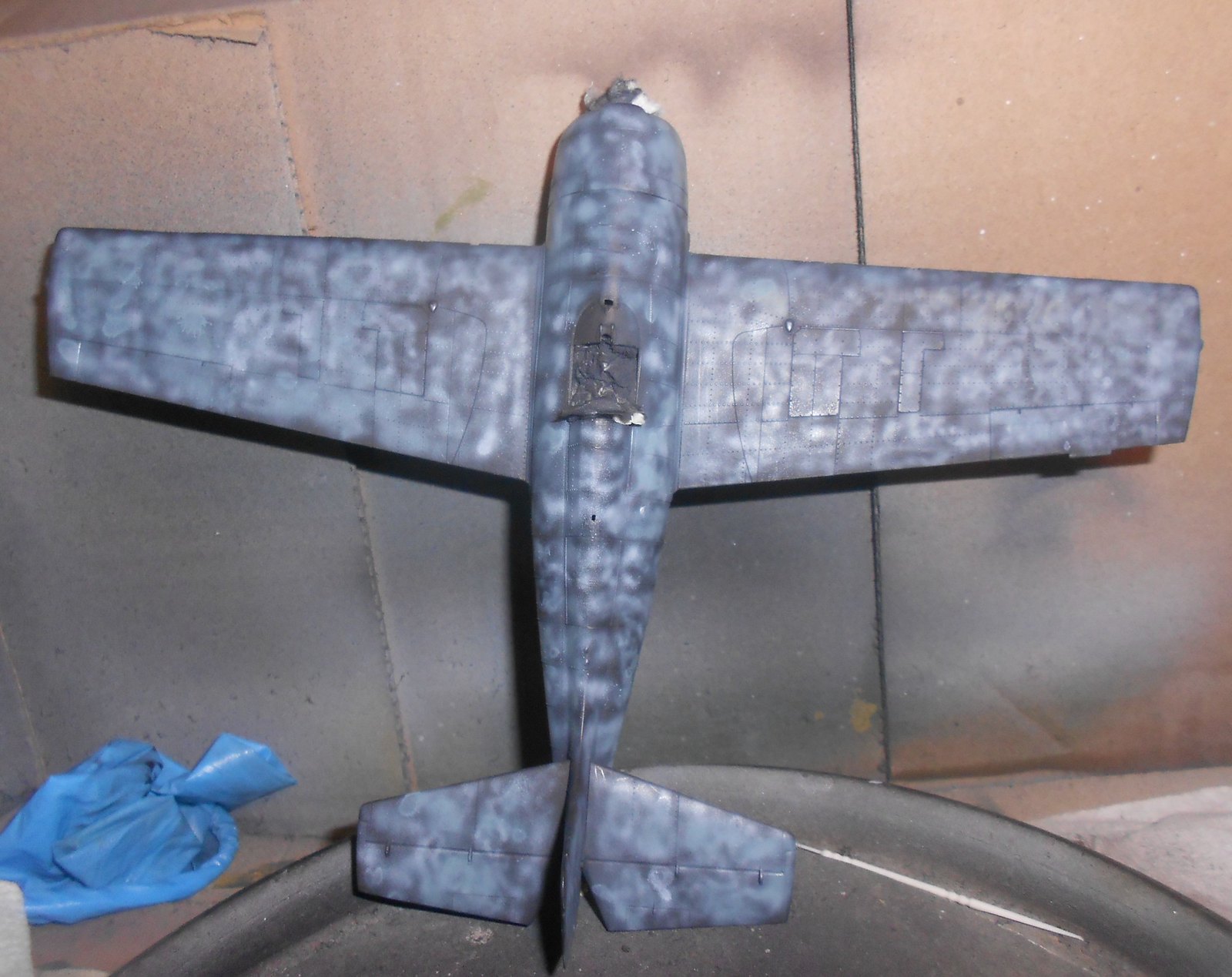More on the Guadalcanal bound Wildcat. As noted earlier, this is going to be another exercise in “black basing.” (If you haven't heard the term, check Ytube under Doog's Models and watch his first video – about 8 minutes, called Black Basing for an introduction. The idea is to dispense with preshading but also amplify tonal variations – just what we want on a plane that's bound for heavy weathering.) The first stage is to paint the primed plane (which is black) with tones of your base color – one of mine is lighter, another darker, the last the base coat – up very close and in very small quantity. The result looks like a bunch of squiggles. Doog does it better, but this is a fair representation of the stage called “Mottling”
 mottle by Eric Bergerud, on Flickr
mottle by Eric Bergerud, on Flickr
After that's done you go over the assigned area (in my case the 2/3 of the area of the Wildcat that's light blue-gray) with a heavily diluted base color. You don't want to finish off the variations in tone – that would be like putting on a base coat over a preshaded model and hiding the preshade. (Sound familiar?) In my case, I'm very pleased with an irregular surface because of what's coming next. The first pic is overall, the second a detail.
 base by Eric Bergerud, on Flickr
base by Eric Bergerud, on Flickr
 base1 by Eric Bergerud, on Flickr
base1 by Eric Bergerud, on Flickr
This looks good to me for now – there's a lot more coming. (Next, of course, will be mottling and base coating the sea gray bottom surfaces – but we'll let that dry overnight first.)
No guarantees on this however. A couple months back I did a 1/48 Tamiya Beaufighter for the RAF GB – it was my first shot at black basing. Here's a detail, and the whole deal. I like it.
 PicFtDet by Eric Bergerud, on Flickr
PicFtDet by Eric Bergerud, on Flickr
 picrtabr! by Eric Bergerud, on Flickr
picrtabr! by Eric Bergerud, on Flickr
Golden High Flow continues to impress me mightily. Black basing is all about “painting small” - very heavily diluted paints, very low psi, mottling done at maybe an inch away from the kit: base is even more diluted but done with a little higher psi and from about three inches. Doog uses Gunze, Tamiya or the new Eastern European lacquer-acrylic that is very like the Japanese brands. Those solvent based paints do indeed excel at that kind of detail painting. Water based acrylics like Vallejo Model Air have real trouble here. You can do it, but the balance of viscosity and psi without getting tip dry is tough. High Flow blows through this kind of thing with zero trouble. It is extremely hard to get tip dry with High Flow – I'm sure there's retarder in there – the stuff is also pretty thin. And its also made by the planet's best producer of acrylic paints. Anyway, go to Blick and buy one bottle of High Flow neutral gray – a lovely color that will be useful anywhere – and try it. Because its agent is polymer you get a kind of film on the model – which is what real paint does. (I don't like solvents, but Tamiya is great paint. If there's one thing I don't like about it, it's that when you paint something properly it looks like the material has changed color. Water based acrylics looks like there's paint over the surface. Real machines, especially with matte surface, look like there's paint over the surface. In practice, by the time weathering is done, the difference (never great) is gone completely. This is terrific paint. For four bucks you can't lose. (Most airbrush companies sell it – along with my beloved Madea Iwata Com.Art.. Amazon sells it, but it's all mixed in with large size bottles, collections etc. Try Blick Arts – terrific site for tons of things at rock bottom prices. A 1 ounce bottle of Neutral Gray is about $4.00 – and nearly twice the volume of most modeling paints. Some of the mixing colors which have very complex pigments are more, but you don't need them unless you want to mix paints. There's about 45 colors – I have about 25. The titanium white and carbon black – two Golden standards – have tremendous opacity.) Golden has several videos on Ytube but it's all aimed at the art crowd. There's a lot to be learned but watching. I'm only now beginning to see how a lot of art techniques like glazing would work super for weathering.
Eric